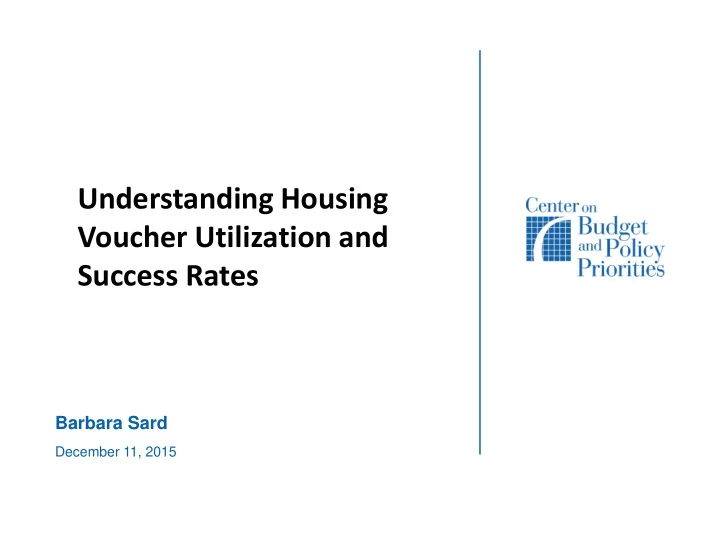

Understanding Housing Voucher Utilization and Success Rates Barbara Sard December 11, 2015
Utilization and Success Rates Defined • Utilization rate: •Commonly, the share of an agency’s authorized vouchers in use on average over a calendar year. • SEMAP allows alternative measure of share of CY renewal budget authority (including offset reserves) spent on voucher subsidies. • Success rate: • Share of newly issued vouchers leased (excluding moving vouchers). 1
Both Measures Matter • Advocates are likely to care both about how the program performs (utilization) and how the program works for particular households (success) • HUD mostly focuses on voucher utilization • Renewal funding eligibility • Performance measurement • No data collected on success rates • PHAs tend to follow HUD’s lead, but the lower the success rate the more administrative time required to achieve a high utilization rate 2
National Picture: Utilization 3
What Affects Voucher Utilization Rate • 2003 HUD study* found: • Unfavorable market conditions – low vacancies and lower quality housing stock – adversely affect utilization. • But effective PHA management can offset market: • Stable leadership attentive to data-driven voucher issuance and staff allocation • Updated waiting list • Attention to factors that drive voucher success rate (landlord relations, housing search assistance and possibly others (e.g., payment standards)) * http://www.huduser.gov/portal/publications/pubasst/cost_util_voucher.html 4
Success Rates • No national data available since HUD 2001 study* which found an average success rate of 69 percent in large metro PHAs • PHA rates varied from 37% - 100% • Market tightness affects success rates • Regardless of market factors, success rates higher if: • payment standards above FMR • jurisdiction prohibits source of income discrimination • most units pass inspection on first try • PHA reached out to landlords. *http://www.huduser.gov/portal/publications/pubasst/sec8success.html 5
CBPP Data on Voucher Utilization • Annual data at the PHA and state level available for 2004 – 2014 and quarterly data beginning in 2012 at http://www.cbpp.org/research/housing/national-and-state-housing- data-fact-sheets 6
Incentives for PHAs to Increase Utilization • Meet community need • More administrative fees (based on vouchers leased) • Some PHAs use other funds to add staff if necessary to get leasing up • Increase following year’s renewal funding • “Use it or lose it” risk of recapture in some years • PHAs with “excess” HAP reserves (including HUD - held) less likely to qualify for adjustment funding or new vouchers (if available) • Failure to use at least 95% of vouchers (or budget authority) likely makes achieving SEMAP high- performer status impossible, and requires corrective action 7
Barbara Sard sard@cbpp.org www.cbpp.org Subscribe to housing policy updates: http://cbpp.us10.list- manage1.com/subscribe?u=fcb519d4a06 d032e8e2bbf63f&id=8fdffd50b8
VOUCHER UTILIZATION STRATEGIES Joseph Villarreal Executive Director Contra Costa Housing Authority
Local Applications for Utilization and Success Rate Challenges Shirley Gibson Directing Attorney
San Mateo County Tight market conditions: • Low vacancy rate of 3% • 50% increase in market rents since 2011 MTW demonstration PHA • FMR flexibility, not limited to 90-110% • blending of HCV and other funds Approximately 4,300 vouchers Utilization rate is about 92% Success rate is about 45%
Moving to Work PHAs Exceptions to the Norm HUD’s Moving to Work (MTW) demonstration provides 39 public housing agencies (PHAs) with flexibility from most statutory and regulatory requirements, such as rent affordability and income targeting. MTW programs impact both public housing residents and housing choice voucher program participants. High utilization rate was a factor in initial selection of some PHAs for demonstration.
SMC Working Group Collaboration of San Mateo County Housing Authority, local housing advocates, and elected officials Common goal: everyone wants to see improved performance of voucher program in the county Measures considered include: • Source of income discrimination protection for voucher usage (county and city) • Development contracts to include HCV acceptance commitment • Landlord incentive program • Marketing to property owners
PHA Measures to Improve Utilization Rate Changes made possible by MTW flexibility: • Changed subsidy calculation to “tiered subsidy table,” share of rent is only loosely tied to income • Has resulted in some hardships to tenants • Regular increases in the total value of the voucher based upon market increases • Increased number of Project-Based Vouchers to increase the overall availability of affordable housing Not dependant on MTW flexibility: • Modified policy on approving voucher extensions • Reduced HQS inspections for consistently passing units
PHA’s Leasing Success Program • Housing locator services provided by contracting organization, targeted to disabled and participants with relocation vouchers close to expiration • Approval of voucher use for shared housing, and contracting with home sharing program to help place voucher holders • Available option for all PHAs • Landlord incentive program pays up to one month “vacancy payment” during transition between tenants if landlord re - rents to another voucher holder within 60 days • Generally PHAs can use admin funds only, unless PBV units • Security deposit funding program for tenants, pays up to 50% of the total deposit • Generally PHAs can implement with admin funds only
Recommend
More recommend